

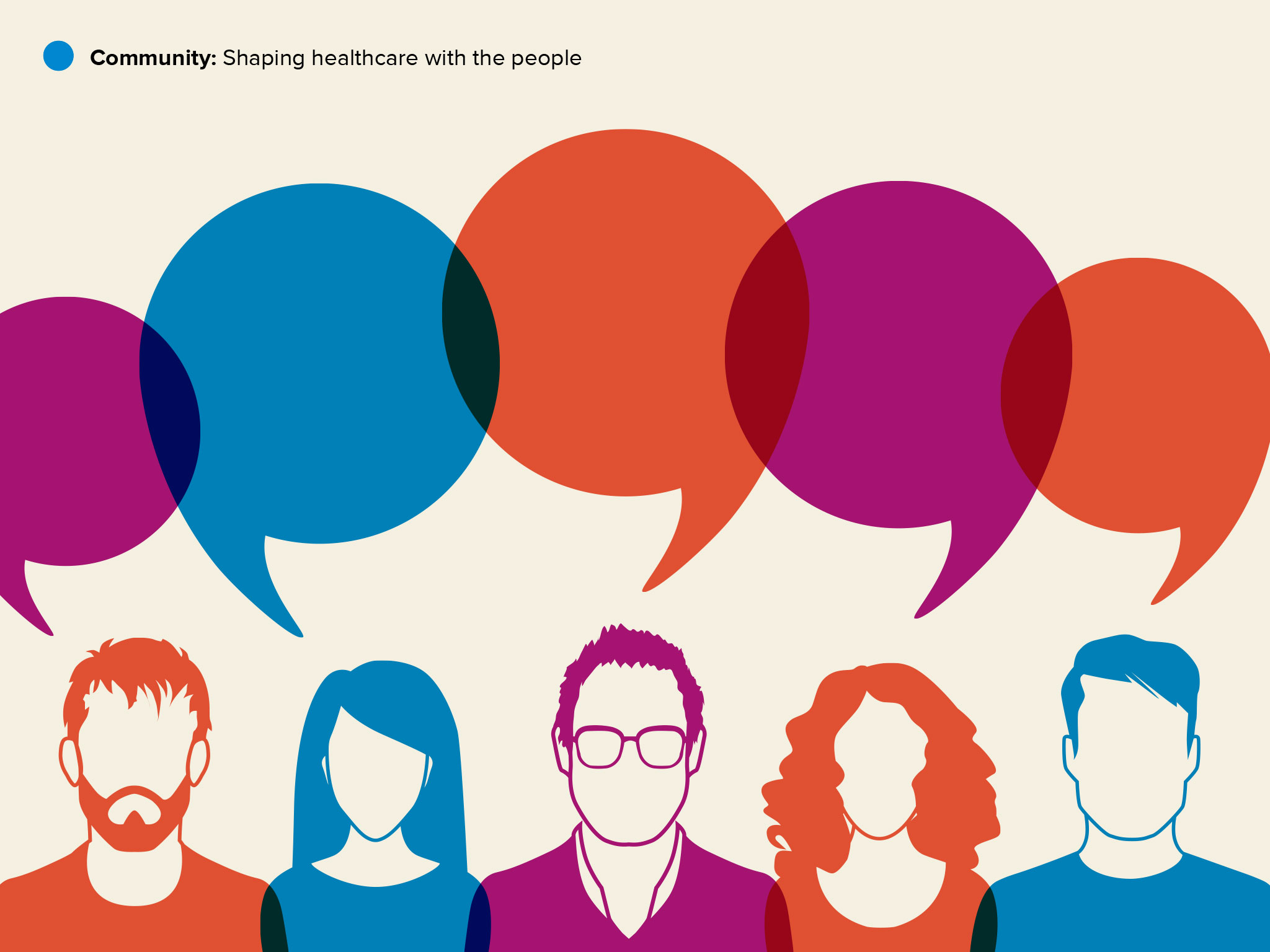
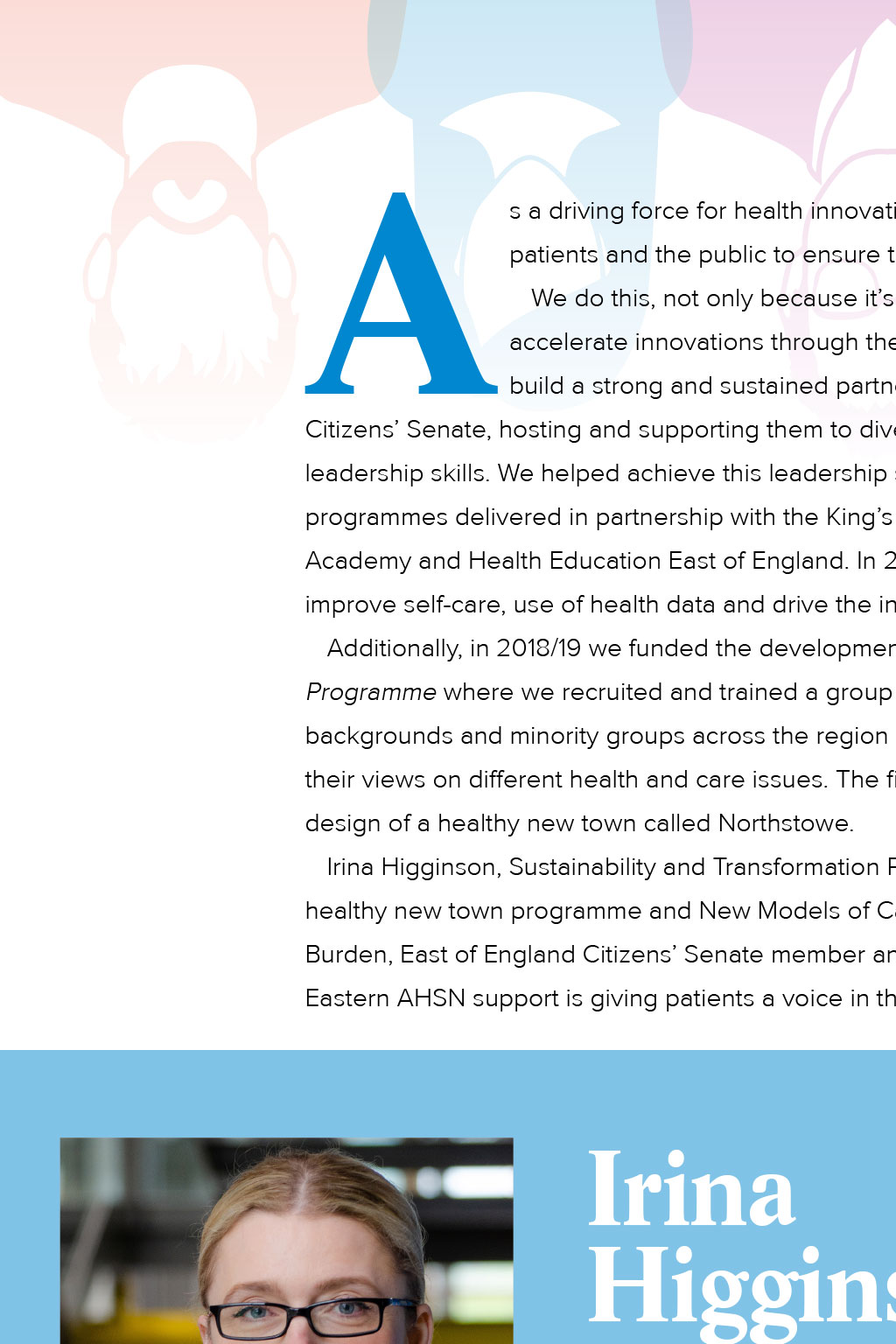
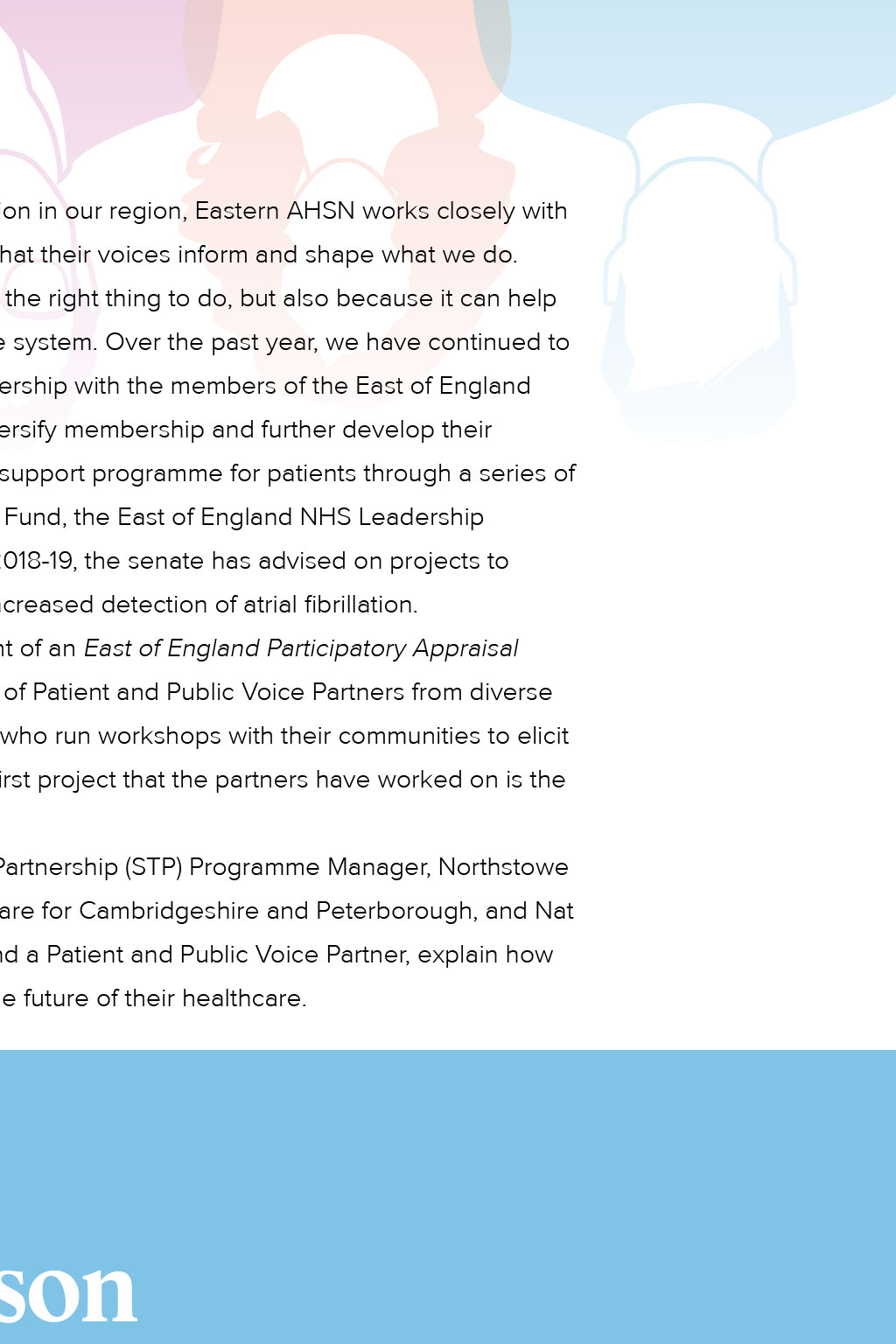
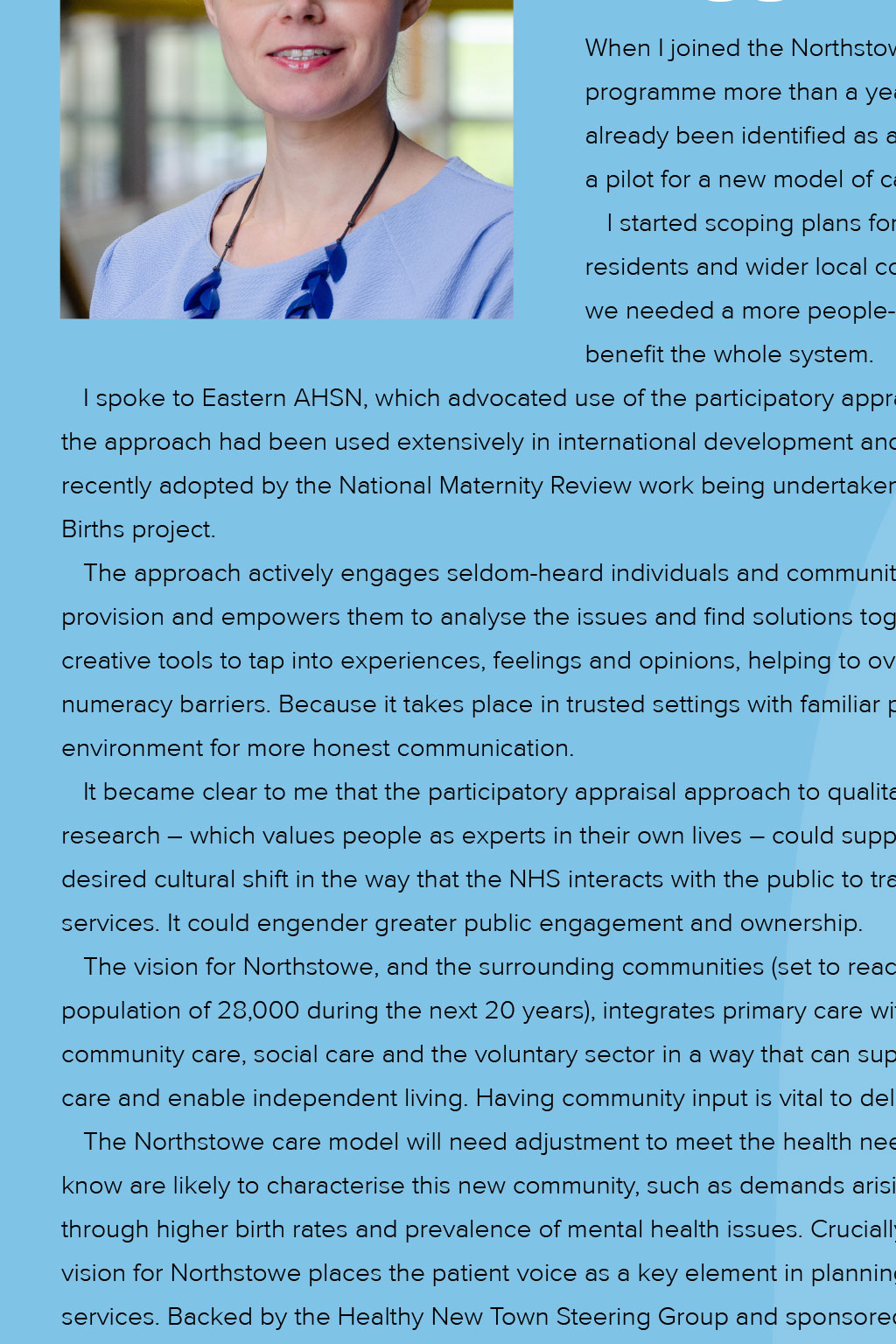
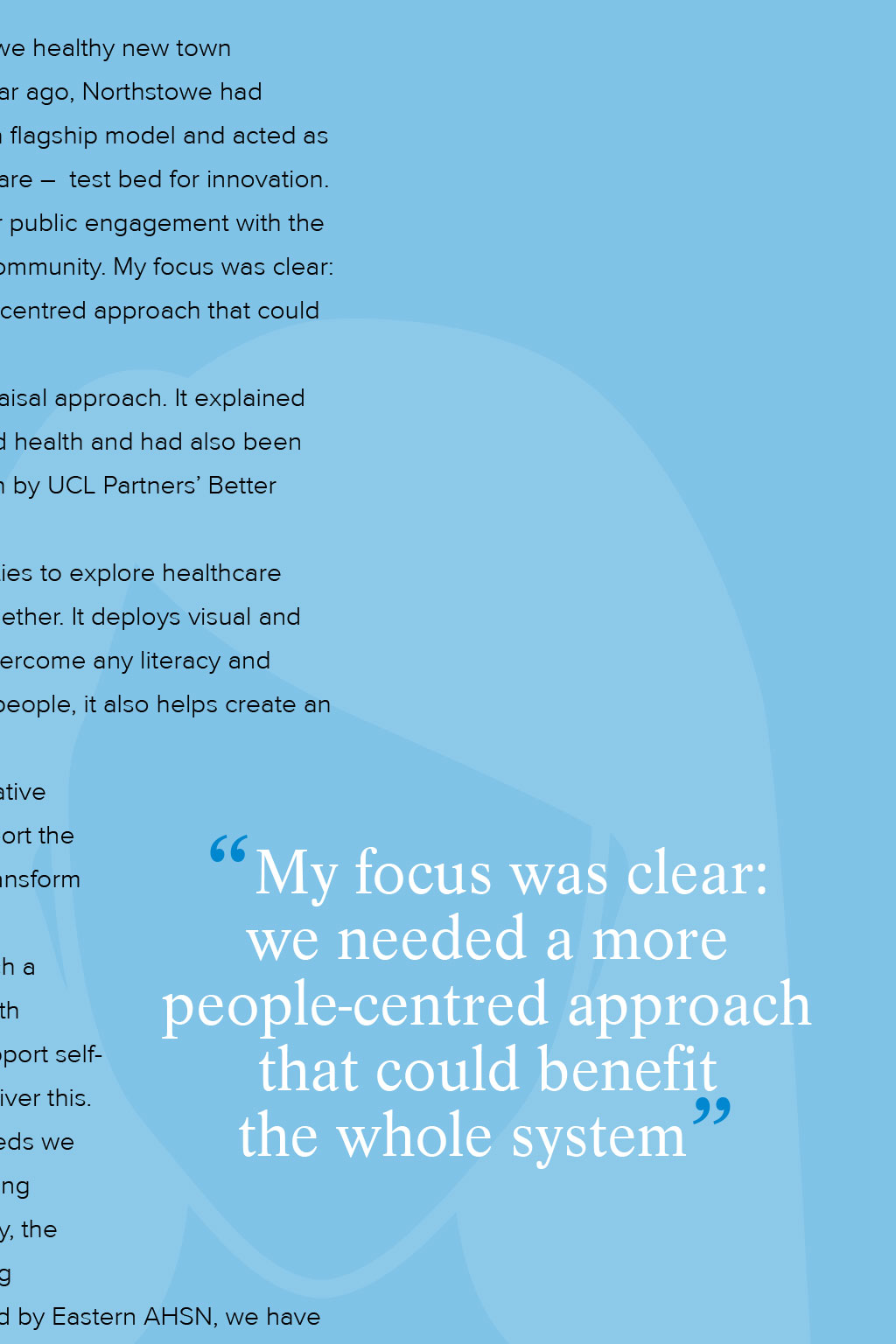
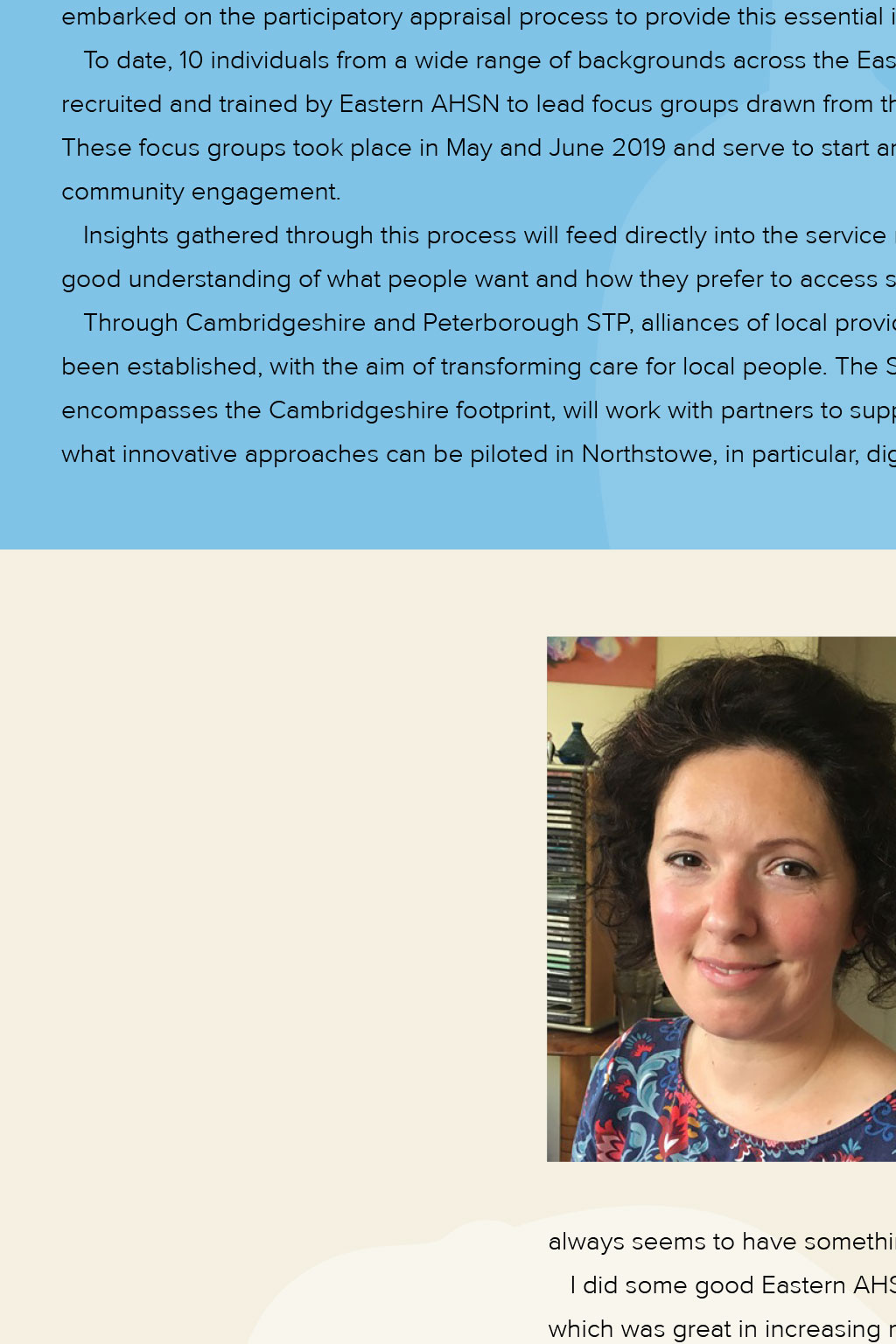
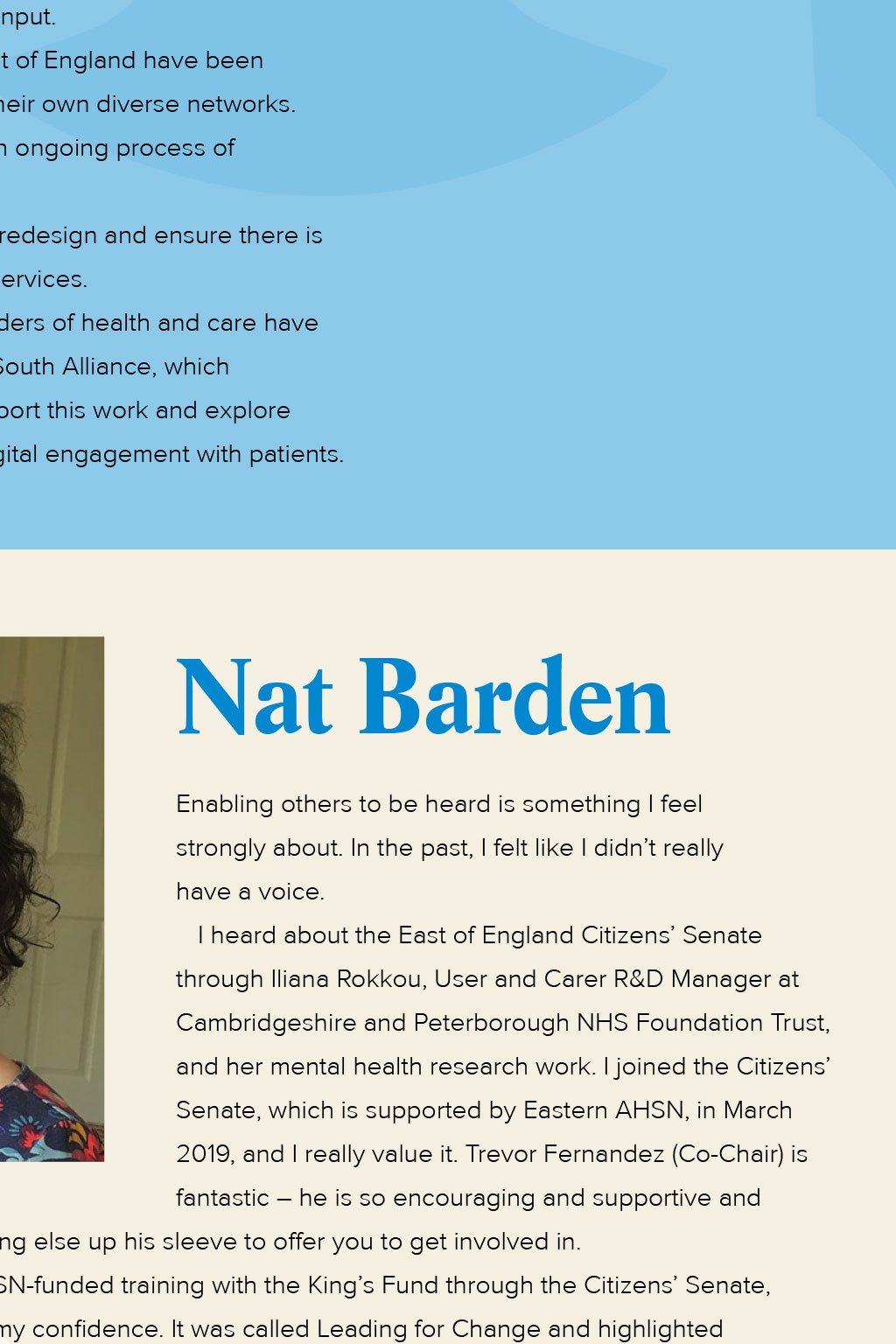

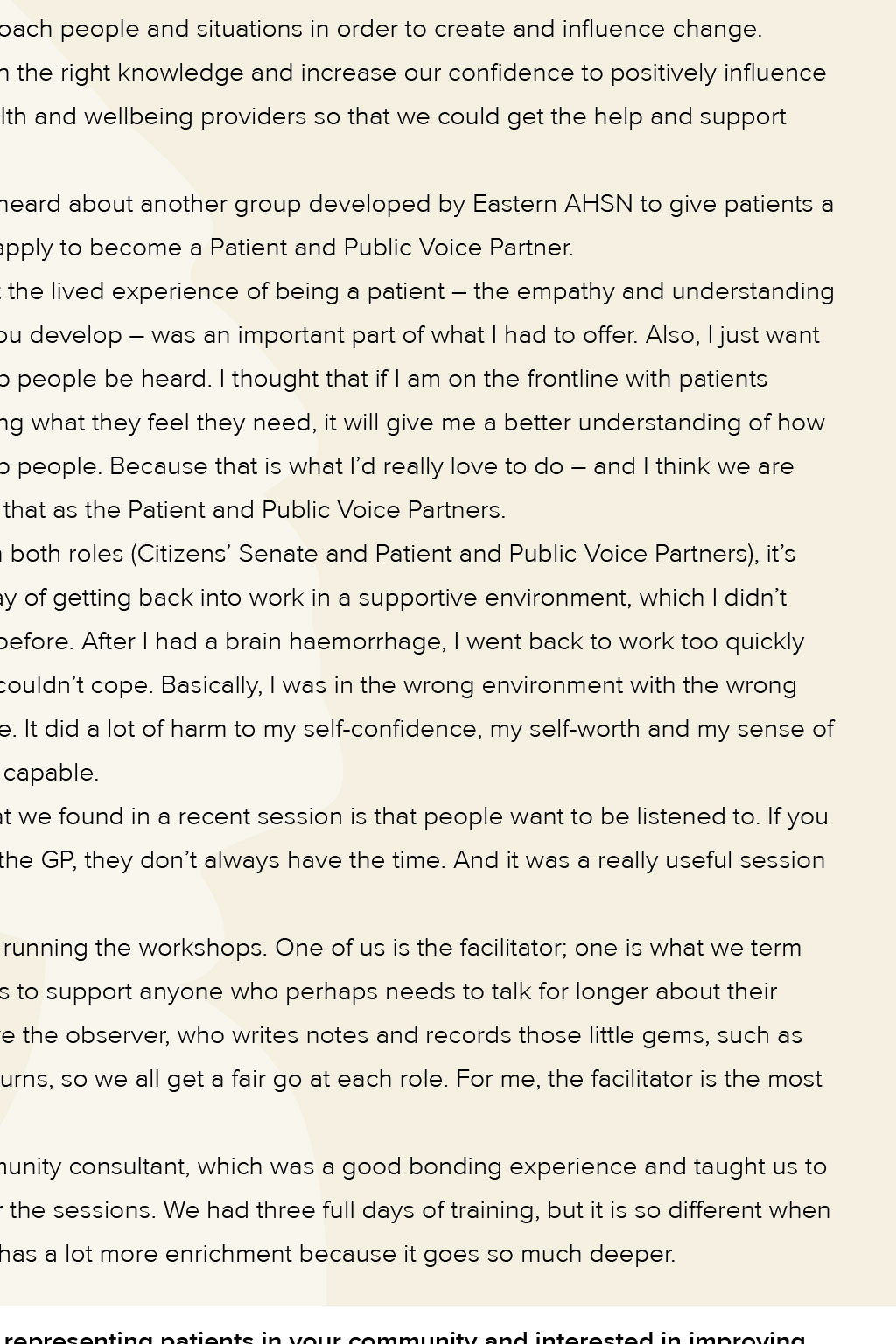
















Community: Shaping healthcare with the people Voice of the people As a driving force for health innovation in our region, Eastern AHSN works closely with patients and the public to ensure that their voices inform and shape what we do. We do this, not only because it’s the right thing to do, but also because it can help accelerate innovations through the system. Over the past year, we have continued to build a strong and sustained partnership with the members of the East of England Citizens’ Senate, hosting and supporting them to diversify membership and further develop their leadership skills. We helped achieve this leadership support programme for patients through a series of programmes delivered in partnership with the King’s Fund, the East of England NHS Leadership Academy and Health Education East of England. In 2018-19, the senate has advised on projects to improve self-care, use of health data and drive the increased detection of atrial fibrillation. Additionally, in 2018/19 we funded the development of an East of England Participatory Appraisal Programme where we recruited and trained a group of Patient and Public Voice Partners from diverse backgrounds and minority groups across the region who run workshops with their communities to elicit their views on different health and care issues. The first project that the partners have worked on is the design of a healthy new town called Northstowe. Irina Higginson, Sustainability and Transformation Partnership (STP) Programme Manager, Northstowe healthy new town programme and New Models of Care for Cambridgeshire and Peterborough, and Nat Burden, East of England Citizens’ Senate member and a Patient and Public Voice Partner, explain how Eastern AHSN support is giving patients a voice in the future of their healthcare. Irina Higginson When I joined the Northstowe healthy new town programme more than a year ago, Northstowe had already been identified as a flagship model and acted as a pilot for a new model of care – test bed for innovation. I started scoping plans for public engagement with the residents and wider local community. My focus was clear: we needed a more people-centred approach that could benefit the whole system. I spoke to Eastern AHSN, which advocated use of the participatory appraisal approach. It explained the approach had been used extensively in international development and health and had also been recently adopted by the National Maternity Review work being undertaken by UCL Partners’ Better Births project. The approach actively engages seldom-heard individuals and communities to explore healthcare provision and empowers them to analyse the issues and find solutions together. It deploys visual and creative tools to tap into experiences, feelings and opinions, helping to overcome any literacy and numeracy barriers. Because it takes place in trusted settings with familiar people, it also helps create an environment for more honest communication. It became clear to me that the participatory appraisal approach to qualitative research – which values people as experts in their own lives – could support the desired cultural shift in the way that the NHS interacts with the public to transform services. It could engender greater public engagement and ownership. The vision for Northstowe, and the surrounding communities (set to reach a population of 28,000 during the next 20 years), integrates primary care with community care, social care and the voluntary sector in a way that can support self- care and enable independent living. Having community input is vital to deliver this. “My focus was clear: we needed a more people-centred approach that could benefi”t the whole system The Northstowe care model will need adjustment to meet the health needs we know are likely to characterise this new community, such as demands arising through higher birth rates and prevalence of mental health issues. Crucially, the vision for Northstowe places the patient voice as a key element in planning services. Backed by the Healthy New Town Steering Group and sponsored by Eastern AHSN, we have embarked on the participatory appraisal process to provide this essential input. To date, 10 individuals from a wide range of backgrounds across the East of England have been recruited and trained by Eastern AHSN to lead focus groups drawn from their own diverse networks. These focus groups took place in May and June 2019 and serve to start an ongoing process of community engagement. Insights gathered through this process will feed directly into the service redesign and ensure there is good understanding of what people want and how they prefer to access services. Through Cambridgeshire and Peterborough STP, alliances of local providers of health and care have been established, with the aim of transforming care for local people. The South Alliance, which encompasses the Cambridgeshire footprint, will work with partners to support this work and explore what innovative approaches can be piloted in Northstowe, in particular, digital engagement with patients. Nat Barden Enabling others to be heard is something I feel strongly about. In the past, I felt like I didn’t really have a voice. I heard about the East of England Citizens’ Senate through Iliana Rokkou, User and Carer R&D Manager at Cambridgeshire and Peterborough NHS Foundation Trust, and her mental health research work. I joined the Citizens’ Senate, which is supported by Eastern AHSN, in March 2019, and I really value it. Trevor Fernandez (Co-Chair) is fantastic – he is so encouraging and supportive and always seems to have something else up his sleeve to offer you to get involved in. I did some good Eastern AHSN-funded training with the King’s Fund through the Citizens’ Senate, which was great in increasing my confidence. It was called Leading for Change and highlighted subtleties in how you can approach people and situations in order to create and influence change. It was intended to equip us with the right knowledge and increase our confidence to positively influence and communicate with our health and wellbeing providers so that we could get the help and support we needed. It was around this time that I heard about another group developed by Eastern AHSN to give patients a voice and I was also asked to apply to become a Patient and Public Voice Partner. “I just want to help people be heard...because that is what I’d really love to do and what I think we are achieving as the Patient and Pub”lic Voice Partners I felt the lived experience of being a patient – the empathy and understanding that you develop – was an important part of what I had to offer. Also, I just want to help people be heard. I thought that if I am on the frontline with patients gauging what they feel they need, it will give me a better understanding of how to help people. Because that is what I’d really love to do – and I think we are doing that as the Patient and Public Voice Partners. With both roles (Citizens’ Senate and Patient and Public Voice Partners), it’s my way of getting back into work in a supportive environment, which I didn’t have before. After I had a brain haemorrhage, I went back to work too quickly and I couldn’t cope. Basically, I was in the wrong environment with the wrong people. It did a lot of harm to my self-confidence, my self-worth and my sense of being capable. What we found in a recent session is that people want to be listened to. If you go to the GP, they don’t always have the time. And it was a really useful session – we got a lot of information. There are always three of us running the workshops. One of us is the facilitator; one is what we term ‘the anti-saboteur’ – their role is to support anyone who perhaps needs to talk for longer about their experiences; and then you have the observer, who writes notes and records those little gems, such as people’s quotes. We take it in turns, so we all get a fair go at each role. For me, the facilitator is the most challenging role. Our training was with a community consultant, which was a good bonding experience and taught us to use all the tools we needed for the sessions. We had three full days of training, but it is so different when you actually do something – it has a lot more enrichment because it goes so much deeper. If you are passionate about representing patients in your community and interested in improving health and social care services in the East of England, please get in touch at ppvp@eahsn.org. Community: Shaping healthcare with the people As a driving force for health innovation in our region, Eastern AHSN works closely with patients and the public to ensure that their voices inform and shape what we do. We do this, not only because it’s the right thing to do, but also because it can help accelerate innovations through the system. Over the past year, we have continued to build a strong and sustained partnership with the members of the East of England Citizens’ Senate, hosting and supporting them to diversify membership and further develop their leadership skills. We helped achieve this leadership support programme for patients through a series of programmes delivered in partnership with the King’s Fund, the East of England NHS Leadership Academy and Health Education East of England. In 2018-19, the senate has advised on projects to improve self-care, use of health data and drive the increased detection of atrial fibrillation. Additionally, in 2018/19 we funded the development of an East of England Participatory Appraisal Programme where we recruited and trained a group of Patient and Public Voice Partners from diverse backgrounds and minority groups across the region who run workshops with their communities to elicit their views on different health and care issues. The first project that the partners have worked on is the design of a healthy new town called Northstowe. Irina Higginson, Sustainability and Transformation Partnership (STP) Programme Manager, Northstowe healthy new town programme and New Models of Care for Cambridgeshire and Peterborough, and Nat Burden, East of England Citizens’ Senate member and a Patient and Public Voice Partner, explain how Eastern AHSN support is giving patients a voice in the future of their healthcare. Irina Higginson When I joined the Northstowe healthy new town programme more than a year ago, Northstowe had already been identified as a flagship model and acted as a pilot for a new model of care – test bed for innovation. I started scoping plans for public engagement with the residents and wider local community. My focus was clear: we needed a more people-centred approach that could benefit the whole system. I spoke to Eastern AHSN, which advocated use of the participatory appraisal approach. It explained the approach had been used extensively in international development and health and had also been recently adopted by the National Maternity Review work being undertaken by UCL Partners’ Better Births project. The approach actively engages seldom-heard individuals and communities to explore healthcare provision and empowers them to analyse the issues and find solutions together. It deploys visual and creative tools to tap into experiences, feelings and opinions, helping to overcome any literacy and numeracy barriers. Because it takes place in trusted settings with familiar people, it also helps create an environment for more honest communication. It became clear to me that the participatory appraisal approach to qualitative research – which values people as experts in their own lives – could support the desired cultural shift in the way that the NHS interacts with the public to transform services. It could engender greater public engagement and ownership. The vision for Northstowe, and the surrounding communities (set to reach a population of 28,000 during the next 20 years), integrates primary care with community care, social care and the voluntary sector in a way that can support self- care and enable independent living. Having community input is vital to deliver this. “My focus was clear: we needed a more people-centred approach that could benefi”t the whole system The Northstowe care model will need adjustment to meet the health needs we know are likely to characterise this new community, such as demands arising through higher birth rates and prevalence of mental health issues. Crucially, the vision for Northstowe places the patient voice as a key element in planning services. Backed by the Healthy New Town Steering Group and sponsored by Eastern AHSN, we have embarked on the participatory appraisal process to provide this essential input. To date, 10 individuals from a wide range of backgrounds across the East of England have been recruited and trained by Eastern AHSN to lead focus groups drawn from their own diverse networks. These focus groups took place in May and June 2019 and serve to start an ongoing process of community engagement. Insights gathered through this process will feed directly into the service redesign and ensure there is good understanding of what people want and how they prefer to access services. Through Cambridgeshire and Peterborough STP, alliances of local providers of health and care have been established, with the aim of transforming care for local people. The South Alliance, which encompasses the Cambridgeshire footprint, will work with partners to support this work and explore what innovative approaches can be piloted in Northstowe, in particular, digital engagement with patients. Nat Barden Enabling others to be heard is something I feel strongly about. In the past, I felt like I didn’t really have a voice. I heard about the East of England Citizens’ Senate through Iliana Rokkou, User and Carer R&D Manager at Cambridgeshire and Peterborough NHS Foundation Trust, and her mental health research work. I joined the Citizens’ Senate, which is supported by Eastern AHSN, in March 2019, and I really value it. Trevor Fernandez (Co-Chair) is fantastic – he is so encouraging and supportive and always seems to have something else up his sleeve to offer you to get involved in. I did some good Eastern AHSN-funded training with the King’s Fund through the Citizens’ Senate, which was great in increasing my confidence. It was called Leading for Change and highlighted subtleties in how you can approach people and situations in order to create and influence change. It was intended to equip us with the right knowledge and increase our confidence to positively influence and communicate with our health and wellbeing providers so that we could get the help and support we needed. It was around this time that I heard about another group developed by Eastern AHSN to give patients a voice and I was also asked to apply to become a Patient and Public Voice Partner. “I just want to help people be heard...because that is what I’d really love to do and what I think we are achieving as the Patient and Pub”lic Voice Partners I felt the lived experience of being a patient – the empathy and understanding that you develop – was an important part of what I had to offer. Also, I just want to help people be heard. I thought that if I am on the frontline with patients gauging what they feel they need, it will give me a better understanding of how to help people. Because that is what I’d really love to do – and I think we are doing that as the Patient and Public Voice Partners. With both roles (Citizens’ Senate and Patient and Public Voice Partners), it’s my way of getting back into work in a supportive environment, which I didn’t have before. After I had a brain haemorrhage, I went back to work too quickly and I couldn’t cope. Basically, I was in the wrong environment with the wrong people. It did a lot of harm to my self-confidence, my self-worth and my sense of being capable. What we found in a recent session is that people want to be listened to. If you go to the GP, they don’t always have the time. And it was a really useful session – we got a lot of information. There are always three of us running the workshops. One of us is the facilitator; one is what we term ‘the anti-saboteur’ – their role is to support anyone who perhaps needs to talk for longer about their experiences; and then you have the observer, who writes notes and records those little gems, such as people’s quotes. We take it in turns, so we all get a fair go at each role. For me, the facilitator is the most challenging role. Our training was with a community consultant, which was a good bonding experience and taught us to use all the tools we needed for the sessions. We had three full days of training, but it is so different when you actually do something – it has a lot more enrichment because it goes so much deeper. If you are passionate about representing patients in your community and interested in improving health and social care services in the East of England, please get in touch at ppvp@eahsn.org. Voice of the people